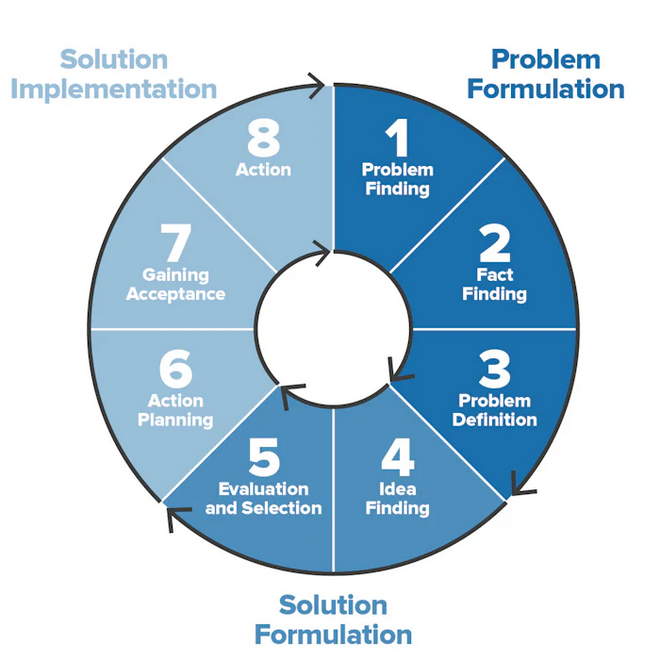More on Problem-solving
Simplexity Thinking or Process
Introduction
We are all continually solving problems; some problems are easy to solve, others are not.
Use the 8 steps to solve a complex problem by grouping them in 3 stages, ie problem formulation, solution formulation and solution implementation (see diagram below).

These 8 steps were initially developed by Min Basadur.
Steps
1. Problem finding (need to find the right issue to be working on, ie do you have enough information to define a problem precisely; 'trigger' questions to help on this
- What do customers want you to improve?
- What are customers complaining most about?
- How do we best help them to do better?
- What current small problems could grow into bigger ones?
- What restricts our work?
- How can we improve quality?
- What are our competitors doing that we are not and could do?
- What is frustrating and irritating for your staff?
- What future challenges do you need to consider, eg changes in markets, customers, their needs, etc?
NB Need to keep in mind external factors like political, socio-economic, legal, technological, etc changes that can influence decision-making.
Need to be continually looking for potential problems, even when the operation is running smoothly, ie
"...proactive problem-solving helps you avoid emergencies and allows you to be calm and in control when issues arise..."
MTCT, 2024e)
2. Fact finding (involves researching the problem holistically, ie analysing the data and information to test the existence and extent of the problem and the viability of solving it; the benefits of solving a problem need to out-weigh the effort and resources used to fix the problem; explore any solutions that others have already tried; determine how the problem impacts other people
"...Work out how different people perceive the situation, explore your customers' needs in more detail, and investigate your competitors' best ideas..."
MTCT, 2024d
Some useful questions:
"...What factors contribute to the problem? Who is involved with it? What solutions have been tried before? What do others think about the problem?..."
MTCT, 2024e
Remember:
"...if you move forward to find a solution to quickly, you risk relying on imperfect information based on assumptions and limited perspectives, so make sure that you research the problem thoroughly..."
MTCT, 2024e)
3. Problem definition (identify and understand the problem at the right level, ie identify its causes, rather than symptoms; many complex problems can be divided into small, more manageable problems, ie break the problem down into its component parts so that you establish specific boundaries for the problem; ask many 'why' questions to broaden your understanding of the issues involved; focus on obstacles hindering progress; need to be careful of negative thinking, ie 'we can't', 'we don't', 'this costs too much', 'we have tried it before', etc; encourage positive thinking, ie 'how might we...'
Can look at the problem from 6 perspectives; customers; staff; business process; top management; owners; environment in which it occurs)
4. Idea generation (identify as many problem-solving ideas as possible; use both analytical thinking and creative brainstorming techniques; be flexible in your approach, ie look from many different perspectives; look for patterns and common elements; learn from others who solved similar, past problems. Additionally,
"...don't evaluate or criticise ideas during this stage. Instead, just concentrate on generating ideas. Remember, impractical ideas often trigger good ones!...'
MTCT, 2024d
NB Record all ideas irrespective of their potential merit)
5. Evaluation and selection (develop criteria for evaluation and selection, ie what elements are important for a realistic and practical solution; based on these criteria evaluate all your potential solutions and select the most suitable one for implementation;
"... Common sense is more important than ego here: be objective, consider each course of action on its merit..."
MTCT, 2024d)
NB The benefits generated must outweigh the costs of problem-solving; solution must be acceptable to key stakeholders; choosing a solution is not the end of the problem solving process)
6. Planning (need to conduct some risk and impact analysis; determine how you are going to implement your solution(s) by developing an action plan, ie determine who, what, when, where, why, and how of delivering the work; need to deliver projects efficiently, successfully and within realistic time frames and budgets)
7. Gaining acceptance (before implementing your plan, need to get the relevant key stakeholders on side, ie sell your idea; need to understand the culture of the organisation so that they will be fostering
"...both a sense of ownership among stakeholders, and an understanding of the benefits they will derive from what you're doing..."
MTCT, 2024d
Be prepared for some resistance
"...listen to what people say, and make changes as necessary. The better the overall solution meets everyone's needs, the greater its positive impact will be..."
MTCT, 2024e)
8. Action (implement your action plan based on the analysis and findings developed in the 7 earlier steps; need to continually monitor and evaluate performance as you implement the project and be prepared to modify, if required; encourage a culture of continuous improvement, ie move onto the next cycle of problem-solving by returning to step 1)
(main source: MTCT, 2024d & e)
